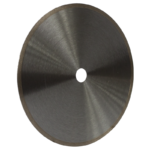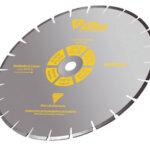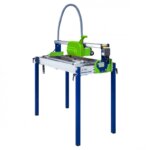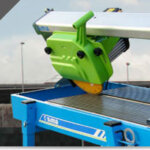When investing in a proper wet tile saw and a diamond blade, maximizing its lifespan is essential. Achieving clean, accurate cuts requires maintaining your blade correctly. This article from SIMA explains critical topics such as how to tell if a diamond saw blade is dull, the process of tile cutter wheel replacement, and factors determining how long diamond blades last. We’ll also cover the importance of dressing the blade to extend its usability.
Contents
How long does a tile saw blade last?
The lifespan of a diamond tile saw blade depends on several factors. Quality, usage conditions, and materials cut all play a role. For instance, a high-quality diamond blade used under ideal conditions —wet cutting, appropriate pauses, and cutting soft materials—can last over 120 hours. On the other hand, a low-quality blade used for hard materials or dry cutting may only last 6–12 hours.
Proper handling, such as avoiding excessive pressure or inappropriate materials, will significantly affect its longevity. Understanding how long a diamond blade lasts helps you plan maintenance and replacements effectively.
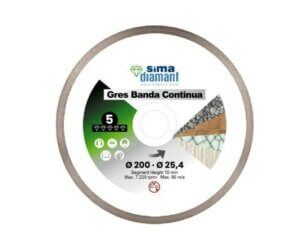
How to know when to replace a tile saw blade
Recognizing the signs of a dull diamond saw blade is crucial to maintaining quality cuts. Odd vibrations or unusual thumping noises when the saw is running may indicate that the blade is worn. Additionally, if you notice a reduction in cutting speed or visible steel core on the blade, it’s time to take action.
Another critical sigh is material damage. If your cuts are causing unnecessary chipping or cracking in tiles, the blade may be too dull. However, try to avoid reaching this stage to prevent wasting materials. Cleaning the blade regularly can help address some issues, as buildup from previous cuts might interfere with performance. Before deciding to replace the blade, consider dressing it to restore its cutting edge, as this process can sometimes bring a seemingly worn blade back to life.
How long does a diamond tile saw blade last?
Do you want the truth? It depends.
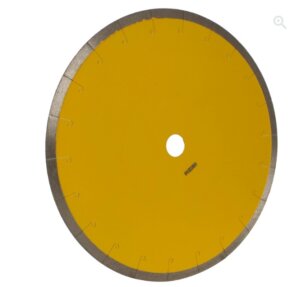
High-quality blades generally last longer, and the type of materials you cut will also influence longevity. Softer materials cause less wear, whereas hard or abrasive materials will reduce the blade’s lifespan.
Cutting technique is another important factor. Using too much pressure or improper methods can shorten the blade’s usability. Wet cutting is recommended, as it reduces heat and friction, extending the blade’s life significantly. While a budget blade might last around 10-12 hours in optimal conditions, professional-grade blades as sold by SIMA can exceed 120 hours with proper care and usage.
How to improve the blade life on a tile saw
To make your tile cutter blade last longer, always match the blade to the material you are working on. Each diamond blade is designed for specific materials, and using the wrong type can accelerate wear. Wet cutting is particularly effective in preventing overheating and reducing friction, so ensure you’re using water where appropriate.
Avoid applying excessive pressure on the blade, as it does not improve cutting speed and may damage the blade or the material being cut. Regularly cleaning the blade and dressing it when necessary will also help you maximize its lifespan, reducing the frequency of tile cutter wheel replacements.
What is “dressing the blade”?
Technically speaking, you are dressing the blade when it has gone dull, and you sharpen it again. The reason why the blade goes dull is basically that the soft metal bond that keeps the diamonds of the blade in place melts over the diamonds. When these diamonds are covered, they can’t cut through any material (concrete, tile, stone, etc.). But if you sharpen it again, you can extend its life expectancy. Shortly, to sharpen a diamond saw blade is to run it through a rough enough material that will abrade the metal away in order to expose the diamonds again without damaging them.
If you are not a professional or you simply have never done this before, your best option is to use a diamond blade dressing stone or rubbing stone. It is a moderately thick, narrow bar of stone with a specific level of hardness and abrasiveness. A grinding wheel or a tool made of silicon carbide can work too, if you happen to have one at home. For example, fire bricks are usually made of 90% silicon carbide, and an obsidian can be used to freshen up the blade to prevent it from getting too dull. In some cases, you can use a cinder block as a makeshift dressing stone.
How to change a wet saw blade
Double check the previous signs that your blade is dull and dressing the blade is no longer an option. Now, you are ready to replace your diamond blade, and this is how you should do it:
- Unplug the saw.
- Loosen the central bolt on the blade backing plate by using a hex key and a box wrench. Do not forget that it has been designed in reverse order to prevent the bold coming undone when working. In other words, it could be the opposite of right-tight and left-loose. How can you know that? You will find the letter ‘L’ on the bolt. That is why it is easier to loosen the bolt by using both wrenches at the same time.
- Examine how the backing plate is settled and put aside the blot and backing.
- Remove the damaged blade.
- If there is an adapter ring around the blade’s arbor hole, keep it.
- Reverse the steps you followed but provide it with a brand-new wet tile saw blade.
- If there was an adapter ring, push It into the arbor hole of the new blade.
- You will find small arrows or angle brackets on the blade and on the saw. Match these direction indicators.
- Diamond blades are designed to cut in only one direction.
- Mount the blade again onto the arbor shaft and put the backing plate back as it was.
- Screw in the central bolt. Start with your fingers and then keep on with the two wrenches. Do not forget that it is left tight, right loose.
- Check that everything is in place and properly working with some waste material before trying to cut expensive materials.

